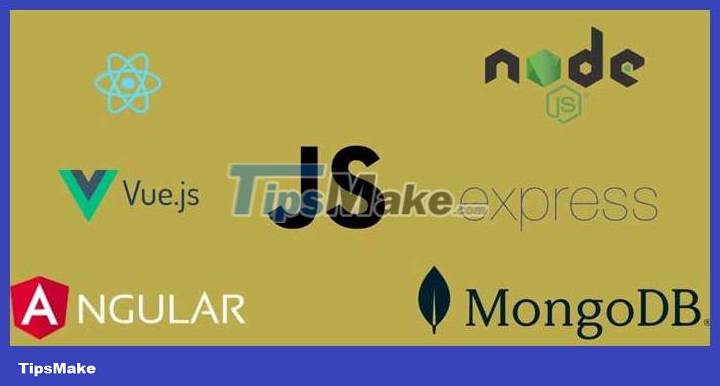Full Stack JavaScript: What are MERN, MEAN and MEVN?
MERN, MEAN, and MEVN are the most popular stacks for full-stack application development . But what is the difference between MERN, MEAN and MEVN in Full Stack JavaScript ?

What is Full Stack JavaScript?
Full Stack JavaScript is a way to use JavaScript both before and after completing the application. JavaScript is famous for its front-end libraries and frameworks, but in the back-end, it now has Node.js.
Although Node.js was not the first attempt at using JavaScript on the server side for software development, it was certainly the most successful. Currently, server-side JavaScript is synonymous with Node.js and JavaScript is officially a full-stack programming language with an extremely popular 3-stack.
What is MERN Stack?
JavaScript's MERN stack is considered the most popular, including 4 main technologies. On the front end of these applications, you have the React library, a popular JavaScript library developed by Facebook. This library became popular due to a number of factors, including its flexibility, performance optimization, and rapid adoption by major technology companies.
The other 3 technologies in this stack are Node.js Express and MongoDB. These technologies work together on the backend of the MERN stack.
Node.js or NodeJS is more than just a framework. It is an asynchronous JavaScript runtime environment that operates on the server side of the application to manage specific processes. The Node.js development team focuses on non-blocking I/O operations. This feature gives Node.js an edge over some of its competitors, by allowing you to develop applications without having to worry about deadlocks.
Another important feature of Node.js is event-driven. That means it uses an event loop as its runtime structure, not a library. This event loop is responsible for the Node.js feature to implement non-blocking I/O operations.
Express or Express.js is a Node.js framework, allowing Node.js to complete specific tasks. For example, Express serves as a tool in how Node.js handles application routing by simplifying the process. In most Node.js applications, Express handles all HTTP requests.
MongoDB is a NoSQL database management system. Like Node.js, MongoDB is a pioneer in its field. MongoDB has long been synonymous with NoSQL databases. Developers love using MongoDB because it is easy to use and less rigid than SQL.
What is MEAN Stack?
The difference between MEAN stack and MERN stack is the technology on the front end - Angular. It is a component-based framework that provides out-of-the-box support for essential web development mechanisms, such as routing. Additionally, Angular acts as a development platform, providing the advanced features you need to get data from external libraries or frameworks. A typical example is its internationalization tool.
The internationalization engine facilitates localization by extracting tagged text for translation into different languages. The tool supports multiple translations and even allows you to format data based on the app user's location. At the back end of MEAN, you have Node.js, Express, and MongoDB.
What is MEVN Stack?
The MEVN stack includes Node.js, Express, MongoDB, and Vue. It is a JavaScript framework. Similar to React and Angular, Vue uses a component-based model, allowing you to develop both simple and complex user interfaces for your applications. This framework includes two core features, providing declarative rendering and reactive capabilities.
Vue framework achieves declarative rendering by allowing you to describe the output of the user interface through JavaScript state. JavaScript state also plays an important role in the reactivity of this technology, as it allows the Document Object Model (DOM) to be updated when changes occur.
Difference between MERN, MEAN and MEVN
| MERN | MEAN | MEVN | |
| Study roadmap | React has an easy learning curve | Angular has a steep learning curve because of its rich feature list and its use of TypeScript. | Vue is considered more beginner-friendly than React because it uses a template syntax that closely resembles HTML, while React uses JavaScript XML (JSX). |
| Ecosystem |
|
|
|
| License and community |
|
|
|
| Flexibility | React is very flexible in terms of project structure and component reuse. | Angular is controversial in terms of project structure due to its many built-in features and conventions. | Vue sits between React and Angular. It provides a high degree of flexibility while also providing its own set of conventions when needed. |
| Safety | React does not provide any built-in security features. | Angular has built-in security that helps prevent (XSS) attacks. | Vue also has built-in security features that help prevent XSS attacks. |
| Display performance | React uses Virtual DOM (VDOM), which is a copy of the actual DOM. When the application's state changes, React creates a virtual representation in the VDOM, then updates the actual DOM in a process called collation. This approach minimizes the amount of actual DOM manipulation (which is an expensive operation). | Angular uses a change detection mechanism to monitor application state and update the DOM when changes are detected. | Vue uses React's Virtual DOM and combines it with its own react system. This essentially gives Vue the best of both worlds when it comes to rendering. |
| Accessible ability | React does not support accessibility. | Angular has a number of tools and features that support accessibility. | Vue does not support accessibility. |
Above are the things you need to know about MERN, MEAN and MEVN in Full Stack JavaScript . Hope the article is useful to you.
 How to use Slot in Svelte
How to use Slot in Svelte Misconceptions about UI/UX design debunked
Misconceptions about UI/UX design debunked Things to know about event-driven programming in Node.js
Things to know about event-driven programming in Node.js How to manage resources in Python using a context manager
How to manage resources in Python using a context manager How to build a Paint application with Python
How to build a Paint application with Python Docker best practices you need to know
Docker best practices you need to know